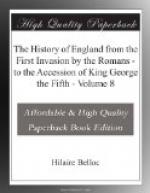[Footnote 1: Clarendon, iii. 138, 510, 515-520. Lansdowne’s Works, ii. 236-241, quoted by Harris, iv. 153. Clarendon Papers, iii. 84, 92 138, 188, 200, 229.]
[Footnote 2: Clarendon Papers, iii. 159, 170.]
his advisers was the number and publicity of his amours; and, in particular, the utter worthlessness of one woman, who by her arts had won his affection, and by her impudence exercised the control over his easy temper. This was Lucy Walters, or Barlow, the mother of a child, afterwards the celebrated duke of Monmouth, of whom Charles believed himself to be the father.[1] Ormond and Hyde laboured to dissolve this disgraceful connection. They represented to the king the injury which it did to the royal cause in England, where the appearances at least of morality were so highly respected; and, after several temporary separations, they prevailed on Walters to accept[a] an annuity of four hundred pounds, and to repair with her child to her native country. But Cromwell sent her back to France; and she returned[b] to Paris, where by her lewdness she forfeited the royal favour, and shortened her own days. Her son was taken from her by the Lord Crofts, and placed under the care of the Oratoriens in Paris.[2]
But if Charles was incorrigible in the pursuit of pleasure, he proved a docile pupil on the subject of
[Footnote 1: She was previously the mistress of Colonel Robert Sydney; and her son bore so great a resemblance to that officer, that the duke of York always looked upon Sydney as the father.—Life of James, i. 491. James in his instructions to his son, says, “All the knowing world, as well as myself, had many convincing reasons to think he was not the king’s son, but Robert Sydney’s.”—Macpherson’s Papers, i. 77. Evelyn calls Barlow “a browne, beautiful, bold, but insipid creature.”—Diary, ii. 11.]
[Footnote 2: James, i. 492; Clarendon’s Own Life, 205. Clarendon Papers, iii. 180. Thurloe, v. 169, 178; vii. 325. Charles, in the time of his exile, had also children by Catherine Peg and Elizabeth Killigrew.—See Sanford, 646, 647. In the account of Barlow’s discharge from the Tower, by Whitelock, we are told that she called herself the wife of Charles (Whitelock, 649); in the Mercurius Politicus, she is styled “his wife or mistress.”—Ellis, new series, iii. 352.]
[Sidenote a: A.D. 1656. Jan. 21.] [Sidenote a: A.D. 1656. July 16.]
religion. On one hand, the Catholics, on the other, the Presbyterians, urged him by letters and messages to embrace their respective modes of worship. The former maintained that he could recover the crown only through the aid of the Catholic sovereigns, and had no reason to expect such aid while he professed himself a member of that church which had so long persecuted the English Catholics.[1] The others represented themselves as holding the destiny of the king in their hands; they were royalists at heart, but how could




